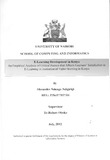| dc.description.abstract | The use of modern technologies in various sectors has gained popularity in contemporary days to
improve effectiveness and efficiency in service delivery. The education sector, too, has witnessed
innovative use of technology to deliver education, a practice commonly known as e-learning. The
term e-learning is a compound term comprised of two parts: the ‘electronic’ part referred to as the
‘e’ and the ‘learning’ part.
This research focused on the theoretical perspective of e-learning, having observed that most of
the previous research in e-learning mainly applied itself to descriptive studies of e-learning
systems, their design, implementation, success stories, and challenges. A closer look at the existing
literature does not reveal any e-learning theory specifically developed to guide the e-learning
practice. Instead, e-learning has relied on the 19th and 20th Century Classical Learning Theories
(CLTs), namely: behaviourism, cognitivism, constructivism, and social constructivism. Though
these theories are applied to e-learning with notable success, they fall short in certain aspects of elearning.
Their main shortcoming stems from the fact that they were stipulated long before elearning
existed with all its modern technologies. Thus the technology concept is missing in them.
Constructivism and social constructivism are the two theories that underpin interaction and
collaboration among e-learners and between e-learners and e-tutors. Connectivism is a more
contemporary theory that aims at explaining the use of contemporary digital technologies to
achieve social connectedness for interaction and collaboration between the parties. However,
taken together, these theories fail to explain certain aspects of interaction and collaboration in elearning
adequately. e-Learning practitioners have appealed to Information System (IS) theories
to explain the ‘e’ part of e-learning. Notably, the IS theories were not stipulated for e-learning but
as general models for technology acceptance. Other researchers had previously observed this
theoretical gap in e-learning, and some of them justified the need for an e-learning theory. Others
laid the foundation upon which future researchers would build such a theory. Therefore, this
research sought to develop a theory for interaction and collaboration that strikes a balance between
CLTs and the IS theories.
The research used Constructivist Grounded Theory (CGT), a suitable methodology for developing
a theory when the existing theories do not adequately explain a phenomenon and whose output is
a theory to clarify the phenomenon. The research involved two Institutions of Higher Learning
(IHLs) in Kenya that the researcher sampled purposively. It involved the researcher interacting
with e-learners, e-tutors, and e-learning managers that were sampled theoretically. The research
used in-depth interviews and participant observation to iteratively collect data from the research
participants. The research obtained qualitative data that was analyzed qualitatively using Atlas.ti.
Data collection followed theoretical sampling, where the researcher pursued participants who
maximized the possibility of getting rich data with the necessary variability. The research used
thematic analysis to identify emergent themes and dimensions from the data, which were further
categorized and sorted into eight key concepts based on the discovered similarities, differences,
and relationships. The key concepts included e-Learner, e-Tutor, e-Learning Technologies, e-
Content, Learner-Learner Interaction, Learner-Tutor Interaction, Learning, and e-Learning
Context. Finally, the key concepts were integrated to form the overarching theme or the core
concept/category, namely ‘the interactive and collaborative e-learning theory.’
The contribution of this research is a theory that explains interaction and collaboration in elearning.
This research appreciates the contributions of the extant theories that have guided elearning
in the past and is in no way proposing that those contributions are not valid or no longer
needed. On the contrary, these theories have been tested repeatedly and have proven to work as
best practices. Thus, certain aspects have been borrowed and integrated with the new findings in
the developed theory. This research believes that it has significantly contributed to e-learning
practitioners, providers, researchers, policymakers, e-learners, e-tutors, and academia.
The research recommends further investigation in the teaching of STEM subjects that involve
practicals via e-learning, which has proved to be a daunting task to both universities in the wake
of resource constraints and limited e-tutors’ ICT and pedagogical competencies. The research also
recommended quantitative testing of the theory in e-learning settings and more IHLs, with
different social and technical environments, to expand its generalizability. | en_US |




